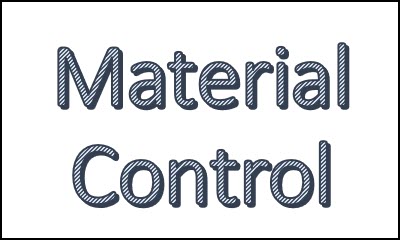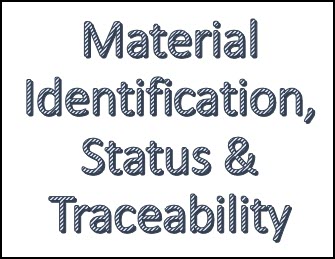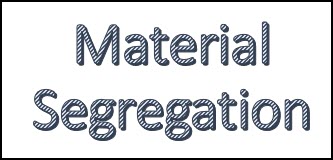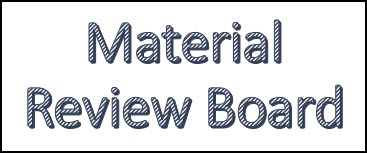 Let’s switching gears for this next chapter and talk for a quick second about Material Control.
Let’s switching gears for this next chapter and talk for a quick second about Material Control.
Most individuals believe that the most difficult thing to control about a product is the process and the product itself, including all of the various CTQ’s associated with the product.
However, there’s another level of complex control that must take place and that’s the material control.
It shouldn’t surprise you when I say that when a product is designed, the designers will define the required materials and components necessary to build a product.
If you attempted to build that product with different material than what is specified, or if you used material that was non-conforming, the product would not function as intended.
Material control is a process to confirm that the right material, that is conforming to requirements, was used when producing the product.
Material Control also includes the process of documenting material consumption to create a traceable history of the components used in the final assembly of a product.
You can see through this statement above that there are two aspects to material control.
Material Control is a combination of both the identification and traceability of materials consumed, but also the ongoing classification of material as either conforming or non-conforming.
The first section within this chapter is dedicated to the Identification, Status and Traceability of Materials to ensure the right components are consumed in building the final product and that traceability is maintained.
The second section is dedicated to the control of non-conforming material which includes Material Segregation, Material (Defect) Classification and the MRB (Material Review Board) process for dispositioning of non-conforming materials.
An Easy Starter Quiz
Hey before you invest of time reading this chapter, try the starter quiz.
[WpProQuiz 86]
If you do really well, then you head down to the final quiz at the bottom.
Material Control Complexity
Before we jump into the first section on Material ID & Traceability, I wanted to share a few thoughts on Material Control.
The effort and complexity associated with your material control process should be risk based and should include factors like regulatory requirements, the complexity of your product, the lifecycle of your product including the expected lifetime maintenance and support, cost, and the risk to the consumers safety.
Simple commodities like nuts/bolts should have a much simpler method for material control than an automobile which is costlier, more expensive, has higher risk to user safety, and has a longer lifespan with respect to maintenance & support.
Okay, let’s jump into the first section – Material Identification, Status and Traceability.
 Material Identification, Status, and Traceability
Material Identification, Status, and Traceability
Many organizations today are familiar with the Identification, Status and Traceability of materials as it is a requirement within the ISO 9001:2015 standard.
The standard also clearly states that all of the requirements associated with Identification, Status and Traceability apply to all of the various stages of your products lifecycle which include your supplier, your production, delivery and installation.
The ISO standard requires that organizations control the unique identification of products and the retainment of documented information needed to enable traceability. This is the identification and traceability requirement.
Material identification ensures that the right inputs (raw material) are used in creating a product (outputs).
Remember, a product only functions as intended when it is manufacturing using the appropriate raw materials, and the only way to consistently use the appropriate raw materials is to appropriately label and identify material.
Material identification should include all appropriate information – part number, lot number, description, revision, manufacture date and location, or any other critical information associated with the material.
Material Identification can also include the stage of the material and a record of what inspections have occurred.
This ISO standard also requires the documented information needed to enable traceability.
Once your material is properly identified with its critical information, it is important to be able to track and trace when, where and how that material was consumed into your final product.
Traceability is a record that provides the ability to trace the history, application and or location of an item.
This might include the raw material inputs, or other inputs to the product, the tests performed, the lot/batch number associated with the product, and where the item was distributed, installed or used.
Traceability provides an organization with the ability to demonstrate that a product was conforming to the design requirements during the manufacturing process.
Traceability records also provide an organization with the ability to perform root cause analysis on complaints received after the product has left the control of the organization. These records also facilitate the ability to recall product if necessary.
Material identification and traceability also prevent or reduce the likelihood of a material mix-up during the manufacturing process. It can also prevent you from inadvertently using non-conforming material.
The ISO standard also requires that you document the status of products with respect to quality requirements throughout the production process.
That is, once you test an item for a quality requirement the status of the material, passing or failing (conforming or non-conforming), must be documented and controlled. This is the Status requirement.
Material Status can also include other information including the processes through which the material has completed and where the material is going next.
When material is non-conforming, there are further requirements for the control of that material. Let go there next.
 Material Segregation
Material Segregation
Appropriately handling non-conforming is critical to success for an organization.
As we discussed in the last chapter during the Control Plan discussion, when a non-conformance is detected step 1
in the reaction plan should always be to identify and segregate all potentially non-conforming material.
Similar to Material ID, Status and Traceability, this topic of Material Segregation is also an ISO 9001:2015 requirement.
The standard requires that you follow a process to control non-conforming material.
The goal here is to prevent the inadvertent use of non-conforming material, and ensure only conforming material is used.
Let’s talk about what to do with non-conforming material once you’ve segregated it.
Material Classification
Let’s be clear – not all defects are created equal.
Your reaction to a non-conformance should always be risk based.
The risk associated with a non-conformance should influence your immediate containment action, the depth of your root cause analysis, and the depth of your corrective actions.
To facilitate a risk-based reaction to a non-conformance, you must classify the non-conformance.
This should include an assessment of the impact the non-conformance might have on the users safety, product performance, reliability, interchangeability, maintainability, appearance, or durability.
The generic approach here is to classify non-conformances into 3 categories, however it’s likely that your organization has its own classification system for non-conformances:
Critical: a non-conformance that could cause an unsafe or hazardous situation for the user or other. This could also include a failure mode that introduces a significant economic risk or renders the product completely non-functional.
Major: a non-conformance that would result in a deterioration in the performance or functionality of a product, but would not introduce a safety risk to the user.
Minor: a non-conformance that is unlikely to cause a safety hazard, nor would it impact the functionality of the product, but might result in a cosmetic issue, or a minor loss in a non-essential feature of the product.
I should also clarify here that the classification of a non-conformance is completely different than the classification of quality attributes.
These two classifications can be related if your non-conformance is somehow associated with a CTQ (Critical to Quality) Attribute, however they are not explicitly linked.
Okay let’s jump into the last section, which is related to the disposition of non-conforming material, which is the Material Review Board.
 Material Review Board
Material Review Board
A cross-functional team of subject matter experts who are responsible for the disposition of non-conforming material.
As you recall from the last section, the final step in the reaction strategy in a control plan is the disposition of affected material.
There are a handful of generally used dispositions, and it’s up to the SME’s on the board to make the final decision.
This team is also required to drive corrective actions using a risk-based approach.
As today’s CAPA programs are maturing many of the disposition decisions and corrective actions are being handled by the individual CAPA investigation teams, and the need for a special MRB Board is slowly fading away.
Conclusion
Alright, that’s it for Material Control!
Remember, material control is necessary to ensure that your product is conforming to the design requirement in relationship to the material used in the production of your product.
Material control is a process to confirm that the right material, that is conforming to requirements, was used when producing the product.
Material Control also includes the process of documenting material consumption to create a traceable history of the components used in the final assembly of a product.
There are two aspects to material control, which form the basis for this chapter.
Material Control is a combination of both the identification and traceability of materials consumed, but also the ongoing classification of material as either conforming or non-conforming.
The first section within this chapter was dedicated to the Identification, Status and Traceability of Materials to ensure the right components are consumed in building the final product and that traceability is maintained.
The second section is dedicated to the control of non-conforming material which includes Material Segregation, Material (Defect) Classification and the MRB (Material Review Board) process for dispositioning of non-conforming materials.
The Final Quiz
[WpProQuiz 87]
